【C++】三大特性之继承
目录
一、继承的概念及定义
1.继承的概念
继承 (inheritance) 机制是面向对象程序设计 使代码可以复用 的最重要的手段,它允许程序员在 保
持原有类特性的基础上进行扩展 ,增加功能,这样产生新的类,称派生类。 继承呈现了面向对象
程序设计的层次结构,体现了由简单到复杂的认知过程。以前我们接触的复用都是函数复用,继
承是类设计层次的复用。
2. 继承定义
2.1定义格式
我们可以看到,Person被称作基类,也叫做父类。Student被称作派生类,也叫做子类。其中的public就是继承方式。
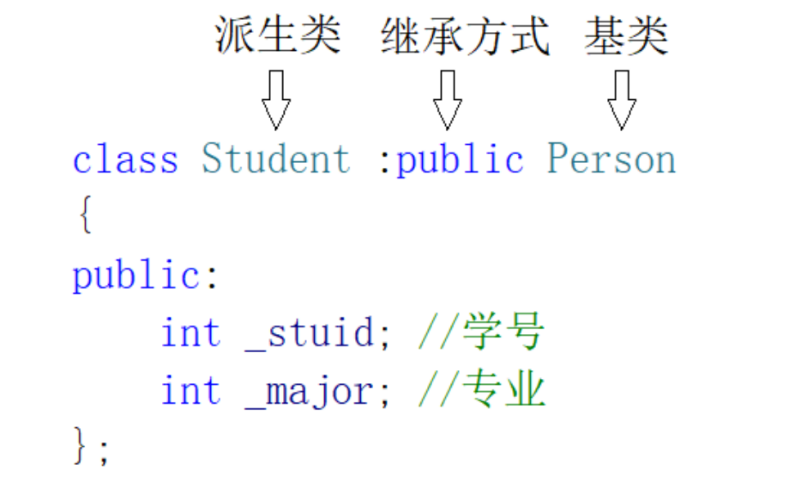
2.2继承关系和访问限定符
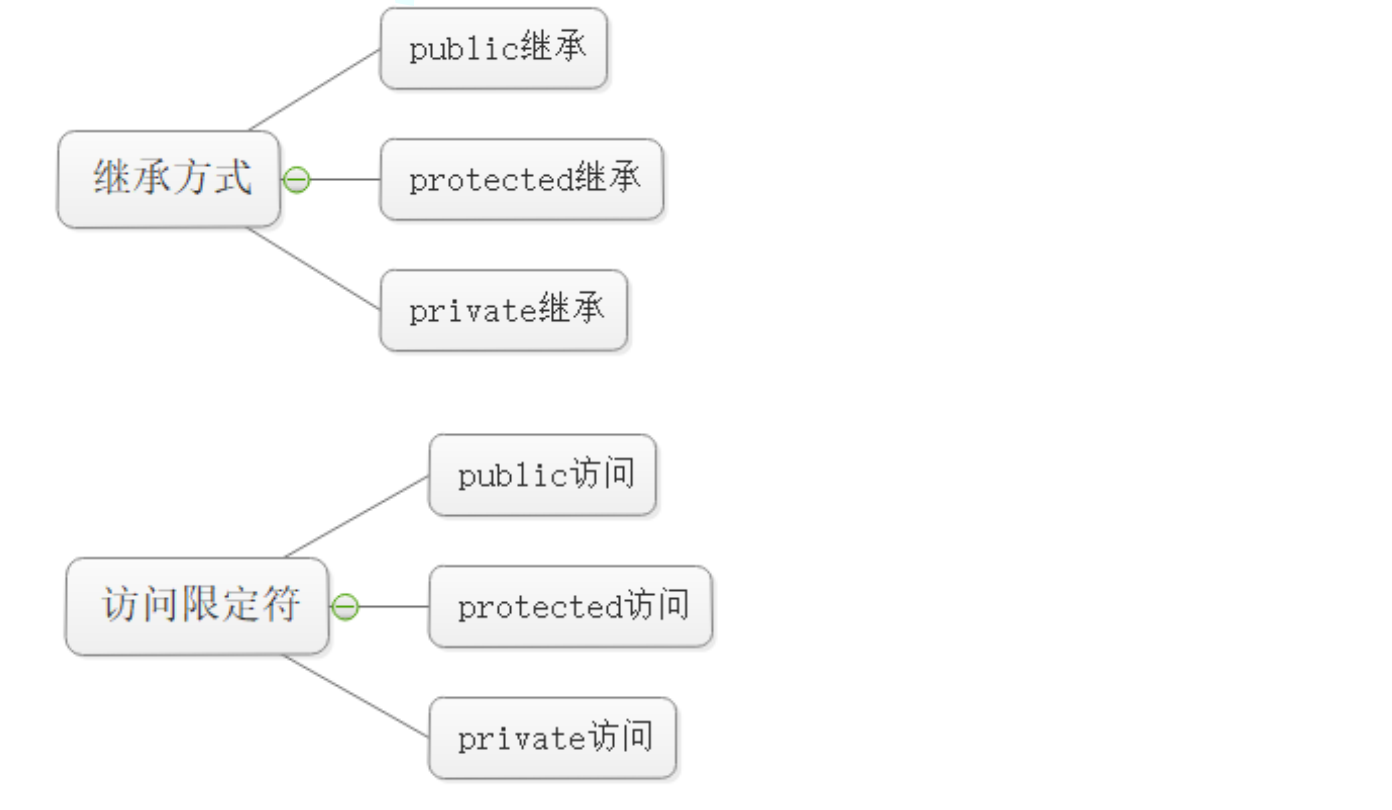
2.3继承基类成员访问方式的变化
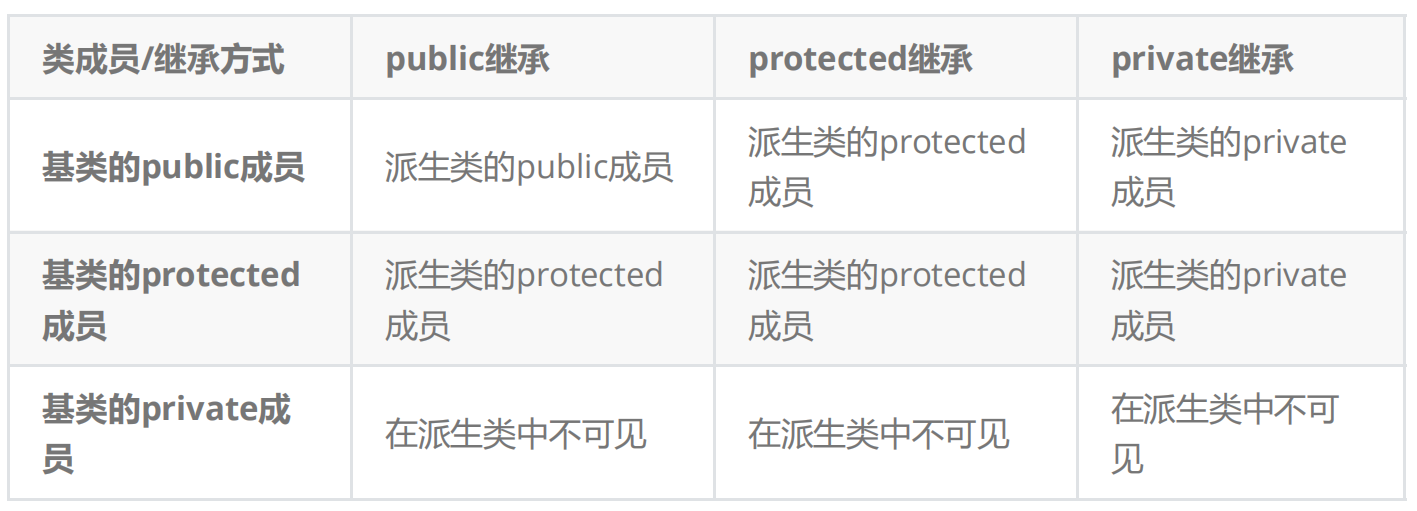
总结:
- 基类private成员在派生类中无论以什么方式继承都是不可见的。这里的不可见是指基类的私有成员还是被继承到了派生类对象中,但是语法上限制派生类对象不管在类里面还是类外面 都不能去访问它。
- 基类private成员在派生类中是不能被访问,如果基类成员不想在类外直接被访问,但需要在派生类中能访问,就定义为protected。可以看出保护成员限定符是因继承才出现的。
- 基类的其他成员在子类的访问方式 == Min(成员在基类的访问限定符,继承方式),public > protected > private。(取权限最小)
- 使用关键字class时默认的继承方式是private,使用struct时默认的继承方式是public,不过最好显示的写出继承方式。
- 在实际运用中一般使用都是public继承,几乎很少使用protetced/private继承,也不提倡使用protetced/private继承,因为protetced/private继承下来的成员都只能在派生类的类里面使用,实际中扩展维护性不强。
二、基类和派生类对象赋值转换
- 派生类对象 可以赋值给 基类的对象 / 基类的指针 / 基类的引用。这里有个形象的说法叫切片或者切割。寓意把派生类中父类那部分切来赋值过去。
- 基类对象不能赋值给派生类对象。
- 基类的指针或者引用可以通过强制类型转换赋值给派生类的指针或者引用。但是必须是基类的指针是指向派生类对象时才是安全的。这里基类如果是多态类型,可以使用RTTI(RunTime Type Information)的dynamic_cast 来进行识别后进行安全转换。(ps:这个我们到多态的时候再说,这里先了解一下)

三、继承中的作用域
- 在继承体系中基类和派生类都有独立的作用域。
- 子类和父类中有同名成员,子类成员将屏蔽父类对同名成员的直接访问,这种情况叫隐藏,也叫重定义。(在子类成员函数中,可以使用 基类::基类成员 显示访问)
- 需要注意的是如果是成员函数的隐藏,只需要函数名相同就构成隐藏。
- 注意在实际中在继承体系里面最好不要定义同名的成员。
我们看下面这段代码,两个类中都有 _num 这个成员,但是Student类中的_num会重定义继承下来的Person类中的_num,最终打印的值为666。
#include <iostream>
using namespace std;
class Person
{
public:
int _num = 999;
};
class Student : public Person
{
public:
int _num = 666;
};
int main()
{
Student s1;
cout << s1._num << endl;
return 0;
}
函数也是同理,即使是函数参数不同,仍然构成隐藏。
class Person
{
public:
void Print()
{
cout << "Person.num = " << _num << endl;
}
int _num = 999;
};
class Student : public Person
{
public:
void Print()
{
cout << "Student.num = " << _num << endl;
}
int _num = 666;
};
int main()
{
Student s1;
s1.Print();
return 0;
}
但是如果我们想要在派生类对象中调用基类中的成员,可以加上作用域。
int main()
{
Student s1;
s1.Person::Print();
return 0;
}
四、派生类的默认成员函数
- 派生类的构造函数必须调用基类的构造函数初始化基类的那一部分成员。如果基类没有默认的构造函数,则必须在派生类构造函数的初始化列表阶段显示调用。
- 派生类的拷贝构造函数必须调用基类的拷贝构造完成基类的拷贝初始化。
- 派生类的operator=必须要调用基类的operator=完成基类的复制。
- 派生类的析构函数会在被调用完成后自动调用基类的析构函数清理基类成员。因为这样才能保证派生类对象先清理派生类成员再清理基类成员的顺序。
- 派生类对象初始化先调用基类构造再调派生类构造。
- 派生类对象析构清理先调用派生类析构再调基类的析构。
- 因为后续一些场景析构函数需要构成重写,重写的条件之一是函数名相同(这个我们后面会讲解)。那么编译器会对析构函数名进行特殊处理,处理成destrutor(),所以父类析构函数不加virtual的情况下,子类析构函数和父类析构函数构成隐藏关系
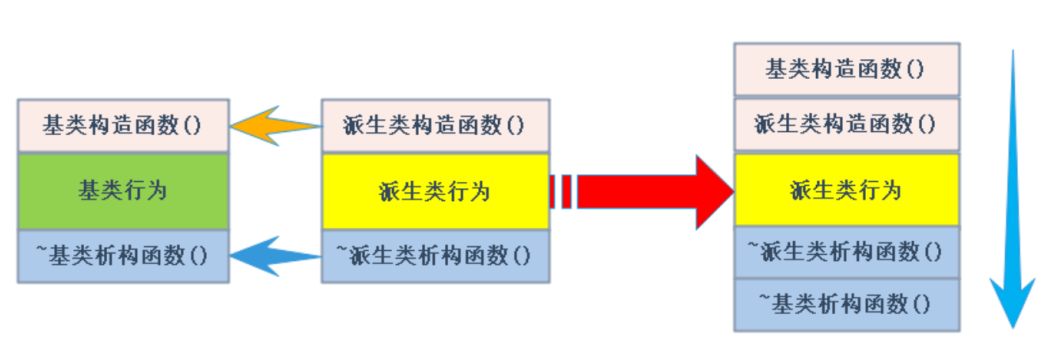
代码:
#include <iostream>
#include <string>
using namespace std;
class Person
{
public:
Person(const string name = "perter")
:_name(name)
{
cout << "Person()" << endl;
}
Person(const Person& p)
:_name(p._name)
{
cout << "Person(const Person&)" << endl;
}
Person& operator =(const Person& p)
{
cout << "Person::operator=(const Person& p)" << endl;
if (this != &p)
{
_name = p._name;
}
return *this;
}
~Person()
{
cout << "~Person()" << endl;
}
protected:
string _name;
};
class Student : public Person
{
public:
Student(string name = "张三", int num = 666)
:Person(name)
,_num(num)
{
cout << "Student()" << endl;
}
Student(const Student& s)
:Person(s)
,_num(s._num)
{
cout << "Student(const Student& s)" << endl;
}
Student& operator =(const Student& s)
{
cout << "Student::operator=(const Student& s)" << endl;
if (this != &s)
{
Person::operator=(s);
_name = s._name;
}
return *this;
}
~Student()
{
cout << "~Student()" << endl;
}
protected:
int _num;
};
int main()
{
Student s1;
/*Student s2;
s2 = s1;*/
return 0;
}例1:
我们看到,初始化继承下来的_name的时候,我们需要用到Person的构造函数,因为我们没有默认构造函数,所以我们需要在初始化列表里面显式调用。


我们看运行结果也能看出。
例2:
我们在拷贝构造函数里也需要用基类的拷贝构造来完成拷贝。


例3:
在 = 号重载的时候也需要基类的 operator= 来完成。


例4:
在调用派生类的析构并且结束之后,会自动调用基类的析构函数。

五、友元与继承
友元关系不能继承,也就是说基类友元不能访问子类私有和保护成员。
其实也很好理解,生活中父亲的朋友未必是儿子的朋友。
#include <iostream>
#include <string>
using namespace std;
class Student;
class Person
{
public:
friend void Print(const Person& p, const Student& s);
protected:
string _name = "张三";
};
class Student:public Person
{
public:
friend void Print(const Person& p, const Student& s);
protected:
int _num = 666;
};
void Print(const Person& p, const Student& s)
{
cout << p._name << endl;
cout << s._num << endl;
}
int main()
{
Person p1;
Student s1;
Print(p1, s1);
return 0;
}六、继承与静态成员
基类定义了static静态成员,则整个继承体系里面只有一个这样的成员。无论派生出多少个子
类,都只有一个static成员实例 。
代码:
我们发现,我们修改了Student类对象中的count值的时候,Person类对象中的count值也发生了改变。
#include <iostream>
#include <string>
using namespace std;
class Person
{
public:
static int _count;
protected:
string _name = "张三";
};
int Person::_count = 0;
class Student:public Person
{
protected:
int _num = 666;
};
int main()
{
Person p1;
Student s1;
s1._count = 1;
cout << p1._count << endl;
cout << s1._count << endl;
return 0;
}
原因:
因为 static 定义的静态成员是在静态区的,而类对象是在栈区,取静态变量的时候不需要解引用读取类对象的内容。
补充:
同样的,我们看下面这段代码:

因为类中的函数是存储在代码段的,所以调用函数也是不需要解引用对象获取的,这里的对象的作用也是传递一个this指针。
七、复杂的菱形继承及菱形虚拟继承
1.单继承
一个子类只有一个直接父类时称这个继承关系为单继承
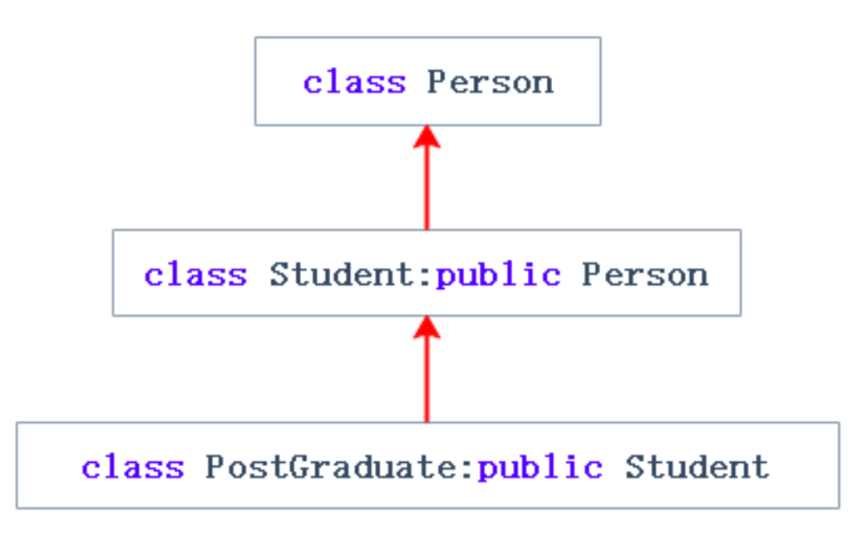
2.多继承
一个子类有两个或以上直接父类时称这个继承关系为多继承
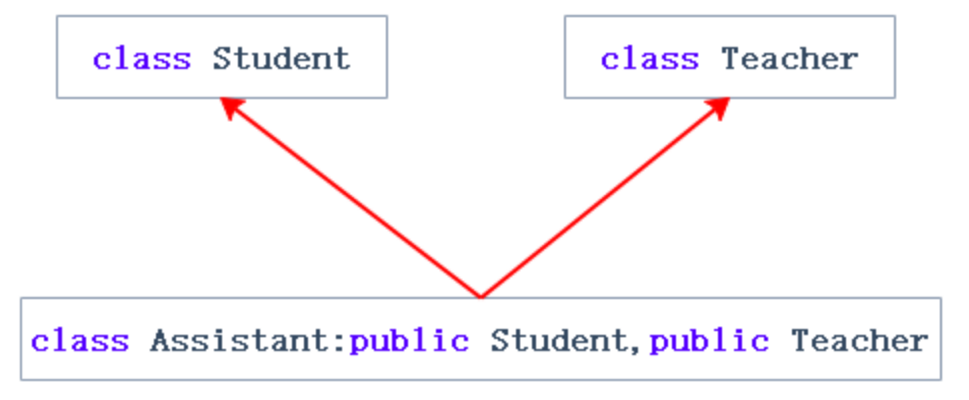
3.菱形继承
菱形继承是多继承的一种特殊情况
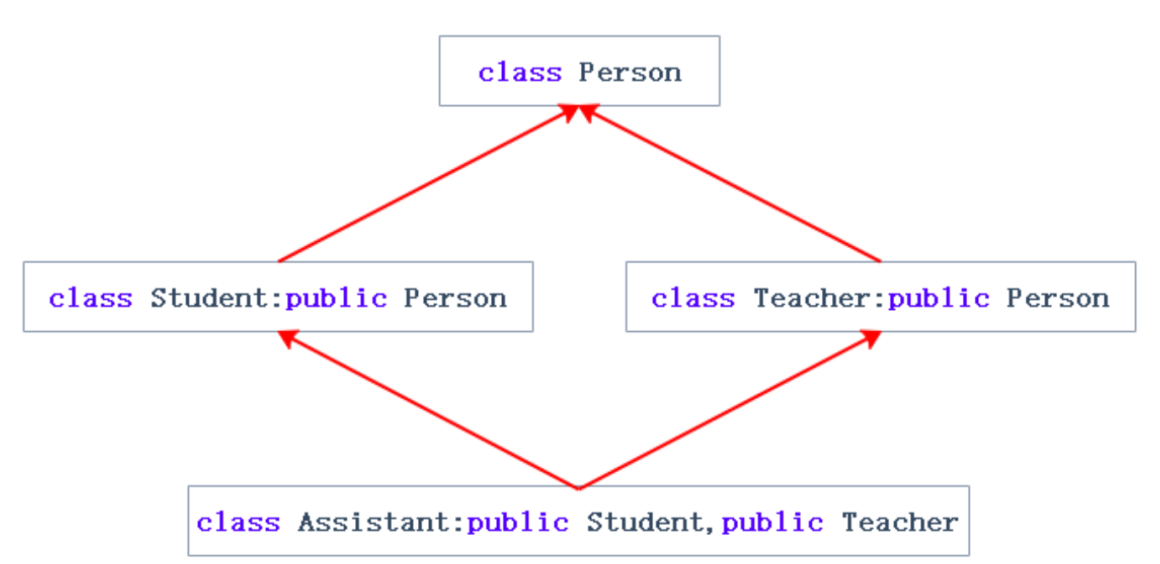
单继承和多继承都还挺好的,但是到菱形继承的时候就出问题了。
菱形继承的问题: 从下面的对象成员模型构造,可以看出菱形继承有数据冗余和二义性的问题。
在 Assistant 的对象中 Person 成员会有两份。
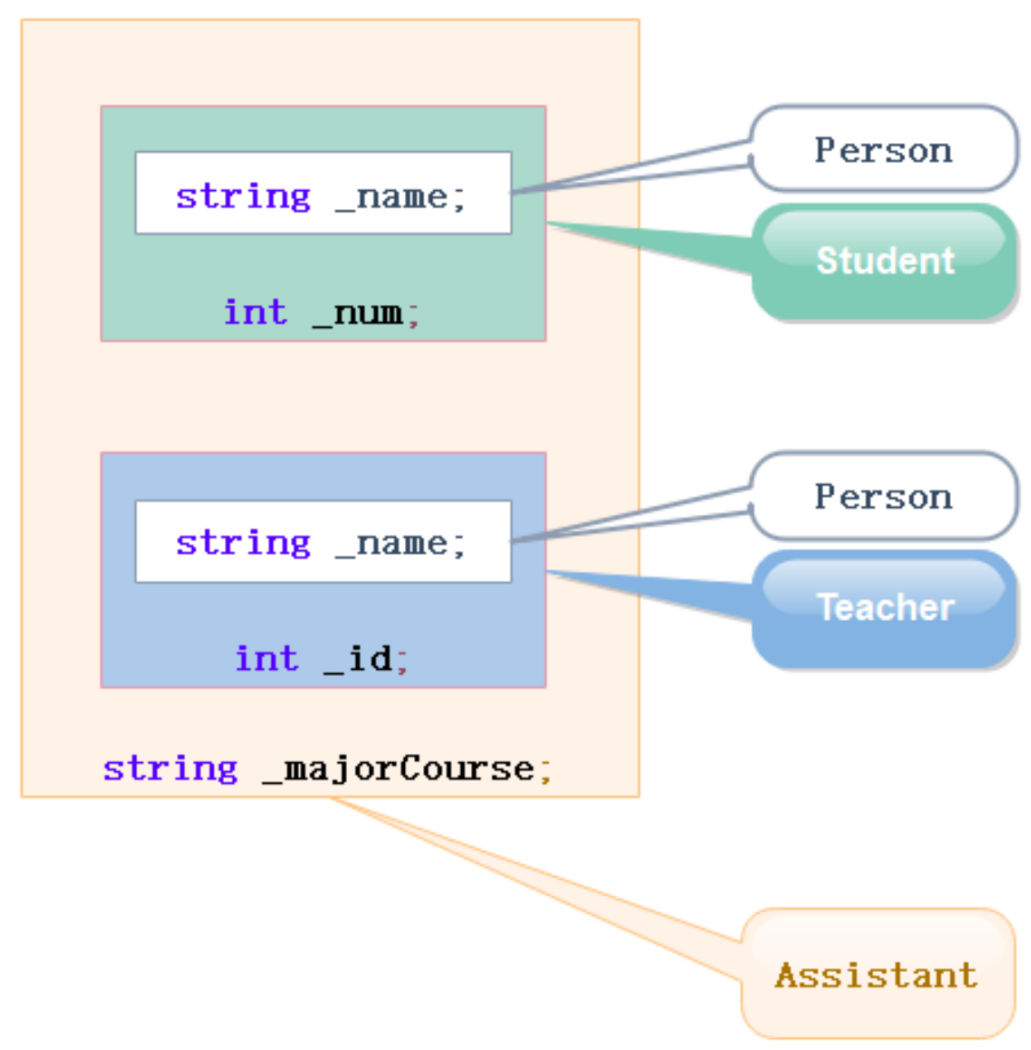
我们在这里赋值的时候,编译器告诉我们不明确。就是因为有重复的部分导致这个赋值不知道赋给哪一个。
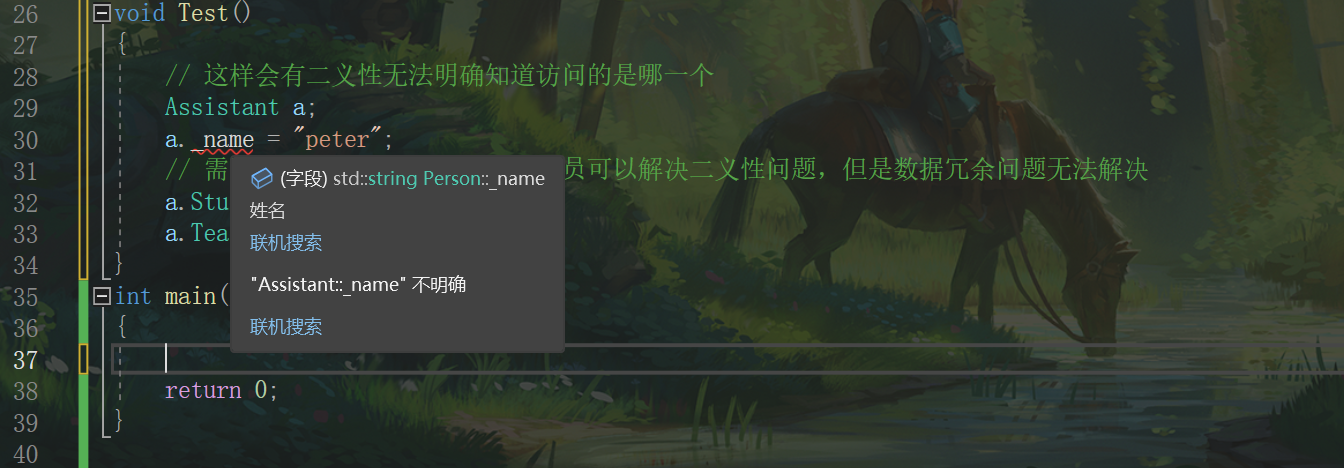
虚拟继承 可以解决菱形继承的二义性和数据冗余的问题。如上面的继承关系,在 Student 和
Teacher 的继承 Person 时使用 虚拟继承 ,即可解决问题。需要注意的是,虚拟继承不要在其他地
方去使用。
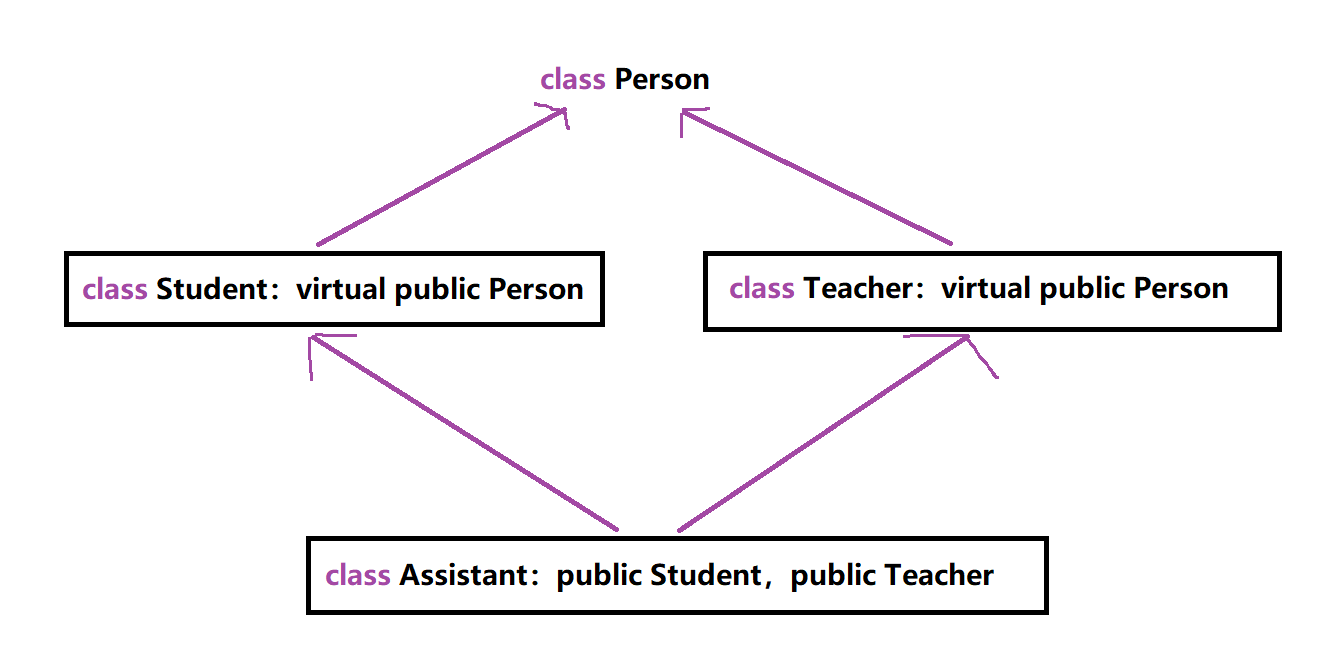
就是在中间两个基类的继承关系前加上一个 virtual 。
为了方便研究,我们将四个类简化成:A、B、C、D,并且从内存查看情况。
代码:
#include <iostream>
#include <string>
using namespace std;
class A
{
public:
int _a;
};
// class B : public A
class B : public A
{
public:
int _b;
};
// class C : public A
class C : public A
{
public:
int _c;
};
class D : public B, public C
{
public:
int _d;
};
int main()
{
D d;
d.B::_a = 1;
d.C::_a = 2;
d._b = 3;
d._c = 4;
d._d = 5;
return 0;
}我们可以将内存分为下图:
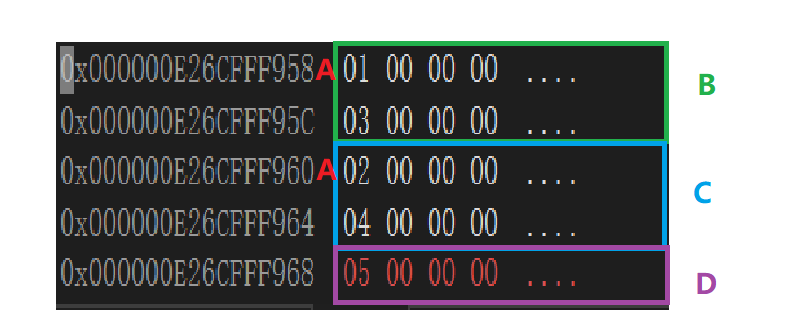
当我们使用虚拟继承的时候:
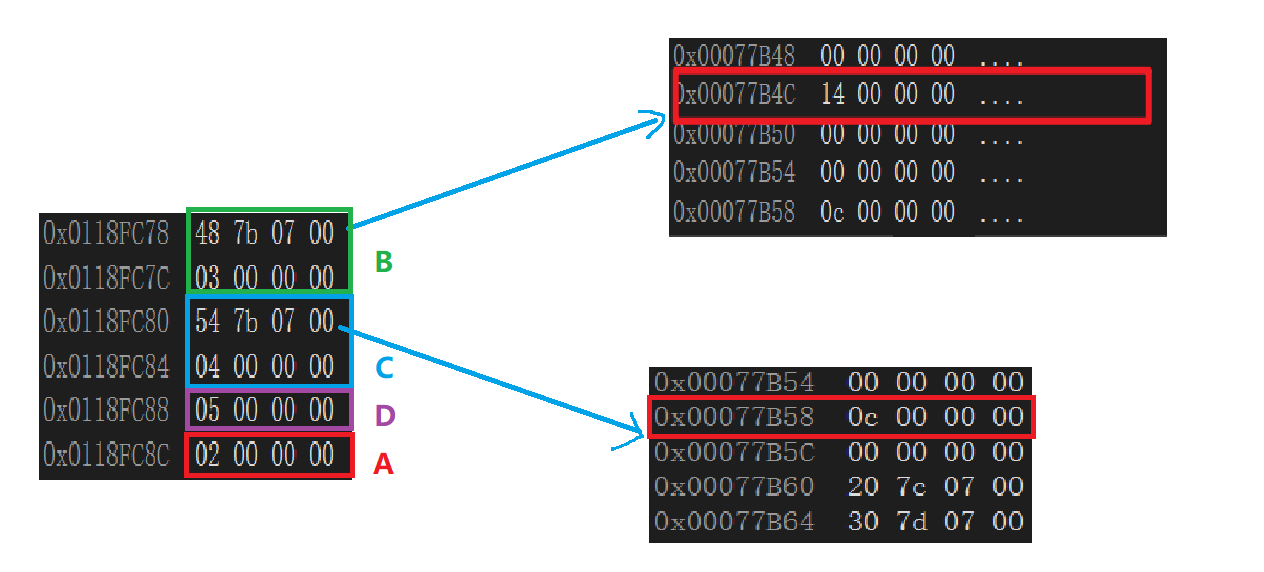
我们发现A中的成员被放到了最后面,原有的B和C类的中放继承的A的成员数据的地方变成了一串地址,指向的地址的第二行记录了距离A中成员的地址偏移量。
这里是通过了 B 和 C 的两个指针,指 向的一张表。这两个指针叫虚基表指针,这两个表叫虚基表。虚基表中存的偏移量。通过偏移量 可以找到下面的 A 。
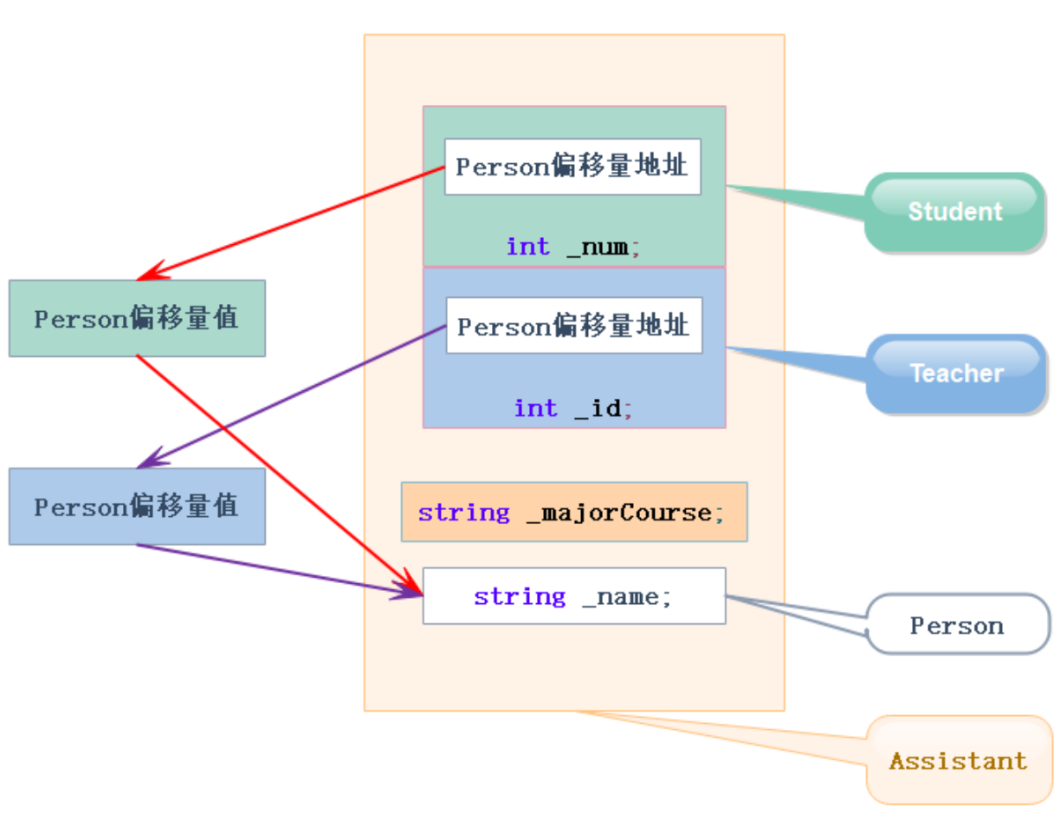
那有人有疑问了 :为什么上面的例子并没有节省空间啊?
其实是因为合并多余数据消耗的空间大于冗余的数据所占的空间,但是如果继承的A类数据很庞大的时候,作用就体现出来了。
八、继承的总结和反思
1. 很多人说 C++ 语法复杂,其实多继承就是一个体现。有了多继承 ,就存在菱形继承,有了菱
形继承就有菱形虚拟继承,底层实现就很复杂。所以一般不建议设计出多继承,一定不要设
计出菱形继承。否则在复杂度及性能上都有问题。
2. 多继承可以认为是 C++ 的缺陷之一,很多后来的 OO 语言都没有多继承,如 Java 。
3. 继承和组合
- public继承是一种is-a的关系。也就是说每个派生类对象都是一个基类对象。
- 组合是一种has-a的关系。假设B组合了A,每个B对象中都有一个A对象。
- 优先使用对象组合,而不是类继承 。
- 继承允许你根据基类的实现来定义派生类的实现。这种通过生成派生类的复用通常被称为白箱复用(white-box reuse)。术语“白箱”是相对可视性而言:在继承方式中,基类的内部细节对子类可见 。继承一定程度破坏了基类的封装,基类的改变,对派生类有很大的影响。派生类和基类间的依赖关系很强,耦合度高。
- 对象组合是类继承之外的另一种复用选择。新的更复杂的功能可以通过组装或组合对象来获得。对象组合要求被组合的对象具有良好定义的接口。这种复用风格被称为黑箱复用(black-box reuse),因为对象的内部细节是不可见的。对象只以“黑箱”的形式出现。组合类之间没有很强的依赖关系,耦合度低。优先使用对象组合有助于你保持每个类被封装。
- 实际尽量多去用组合。组合的耦合度低,代码维护性好。不过继承也有用武之地的,有些关系就适合继承那就用继承,另外要实现多态,也必须要继承。类之间的关系可以用继承,可以用组合,就用组合。
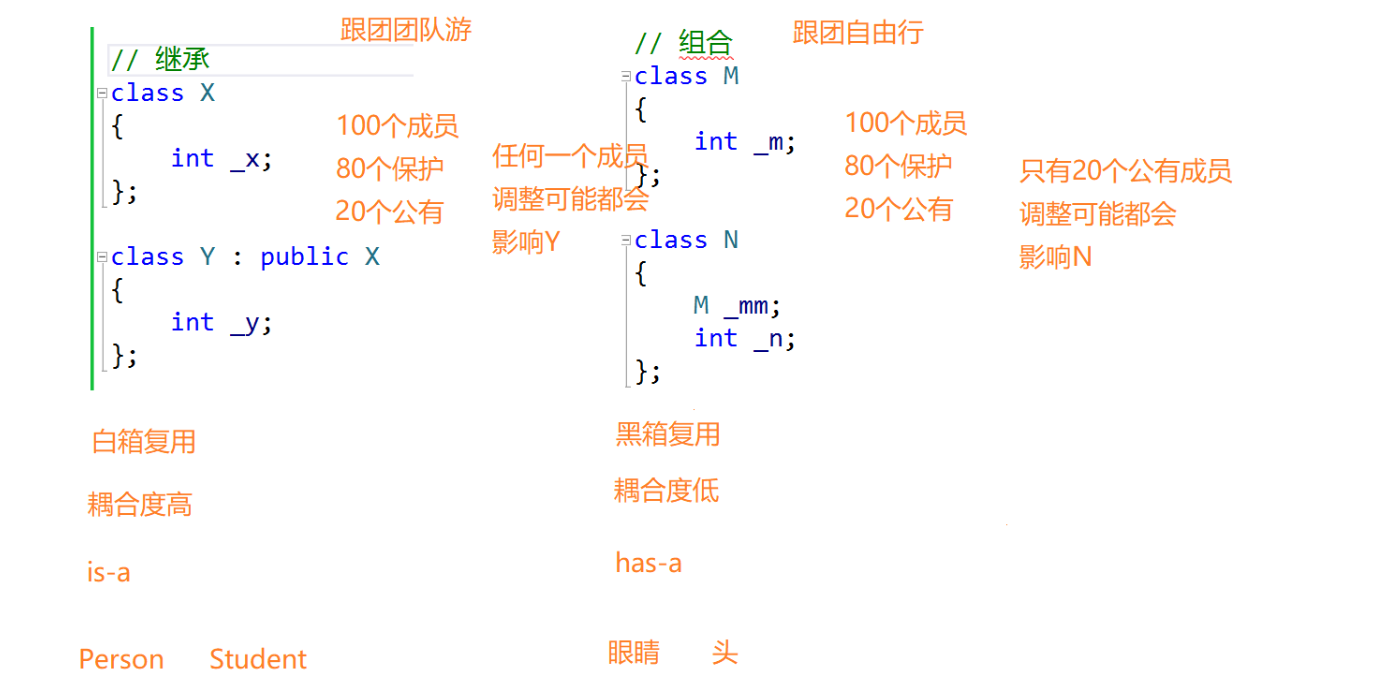
本文参与 腾讯云自媒体同步曝光计划,分享自作者个人站点/博客。
原始发表:2023-02-04,如有侵权请联系 cloudcommunity@tencent.com 删除
评论
登录后参与评论
推荐阅读
目录


